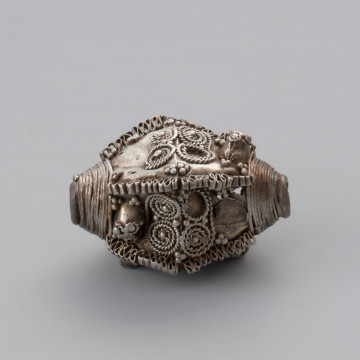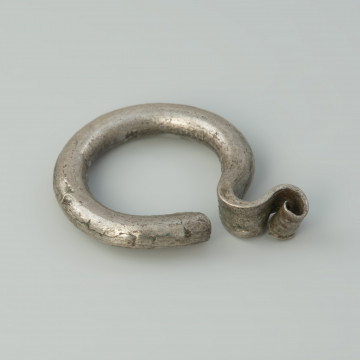
Silver bead
951 — 1000
National Museum in Szczecin
Part of the collection: Middle Ages
The collection of the National Museum in Szczecin holds a unique hoard of silver ornaments and coins, discovered by accident in 1859 during agricultural works in Kurów. The hoard was placed in a small clay vessel. It was buried after 991 at the earliest. It contained nearly 60 grams of silver, mostly Arab and German coins, and one Danish coin. During World War II, a part of the hoard was lost. Only five of the 29 coins in the hoard have survived to this day. Four of them are Arab coins related to the Abbasid dynasty, one coin comes from Persia in the period of the Sassanid Empire. The Baltic lands, which in the early Middle Ages were mostly occupied by West Slavic tribes, were mainly supplied with Arabic coins by merchants maintaining long-distance trade links with the states of the Middle Eastern Caliphate from the 8th/9th centuries. They were used as means of payment, based on their weight and type of metal used for minting them. The Kurów coin has a diameter of 2.5 centimetres. It was struck from silver plate weighing 2.7 grams at the Al-Basra mint in the territory of modern-day Iraq between 754 and 775, during the reign of the Abbasid caliph Al-Mansur (born in ca. 712).
Grzegorz Durdyń
Author / creator
Dimensions
cały obiekt: height: 0.08 cm
Object type
arabic coin, coin, medium of exchange
Technique
minting
Material
silver
Origin / acquisition method
legal transfer
Creation time / dating
Creation / finding place
Owner
Muzeum Narodowe w Szczecinie
Identification number
Location / status

951 — 1000
National Museum in Szczecin

966 — 1100
National Museum in Szczecin

1055 — 1100
National Museum in Szczecin
DISCOVER this TOPIC
Museum of King Jan III's Palace at Wilanów
DISCOVER this PATH
Educational path